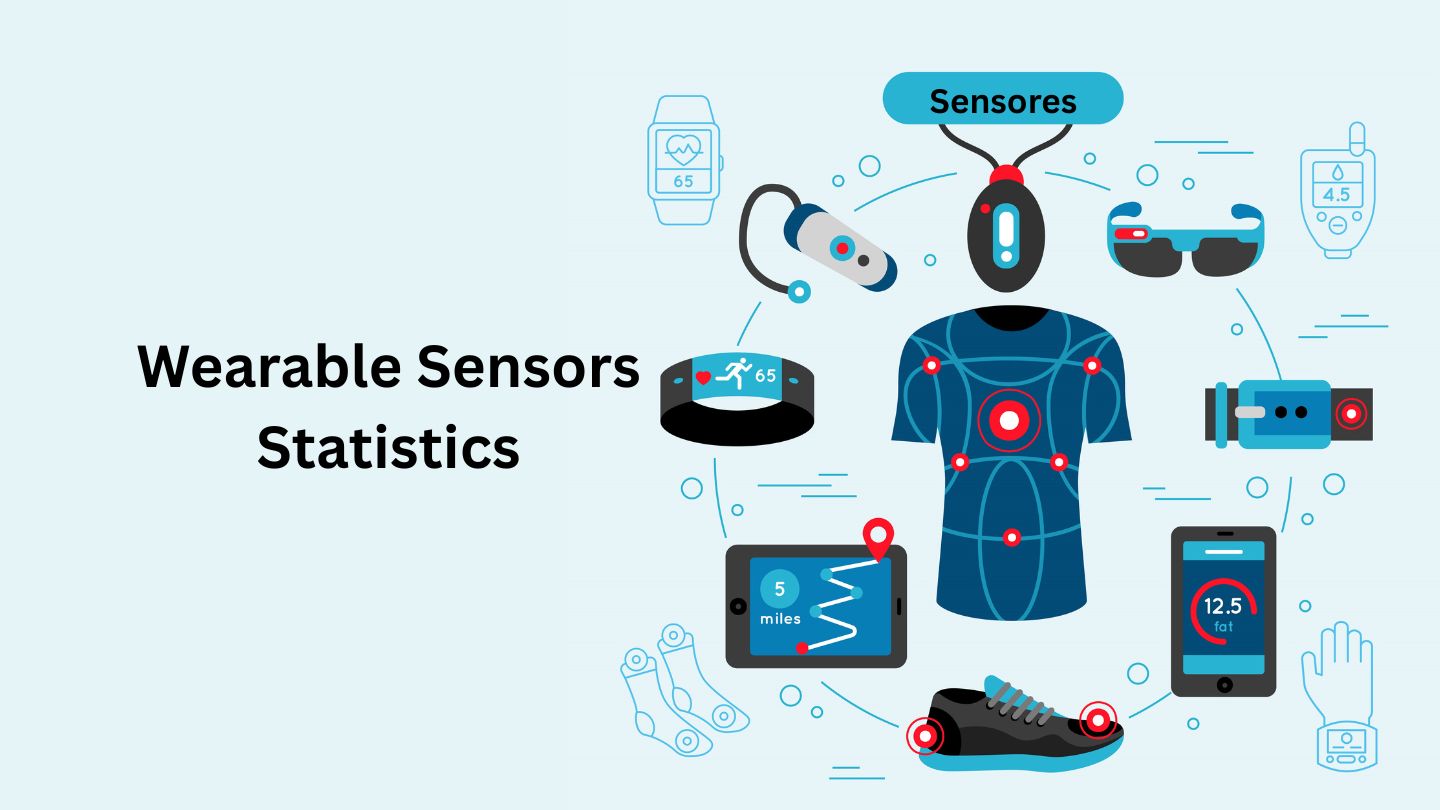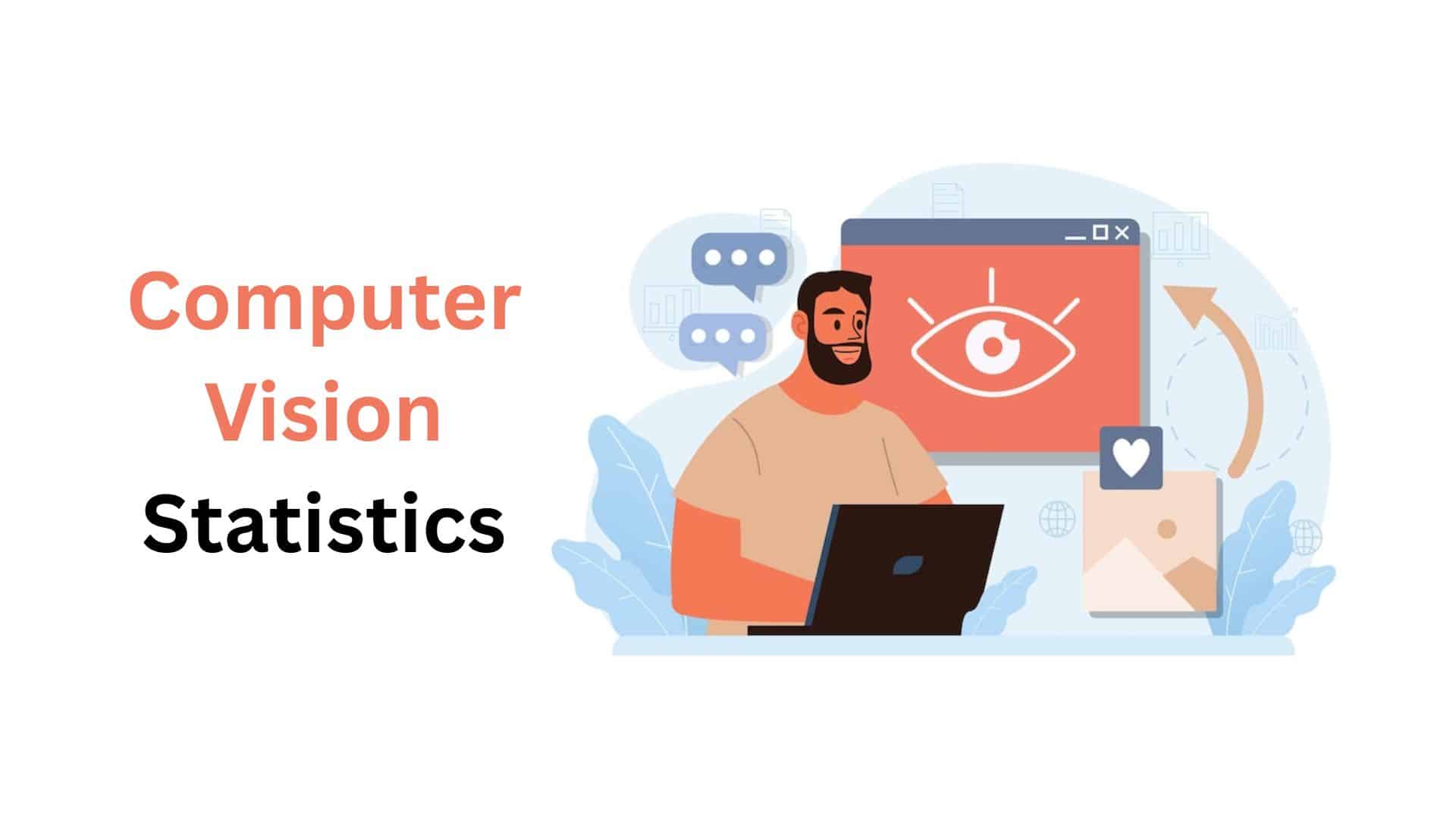Millennial Marketing Statistics By Behavior, Technology, Purchasing Habits, Social Media and Challenges

Updated · Feb 11, 2025


TABLE OF CONTENTS
- Introduction
- Editor’s Choice
- What Is Millennial Marketing?
- General Millennial Marketing Statistics
- How To Do Millennials Consume Media Marketing
- Millennial Consumer Behavior Statistics
- Millennials And Technology Statistics
- Millennials Purchasing Habits Statistics
- Millennial On Social Media Statistics
- Challenges of Marketing to Millennials
- Conclusion
Introduction
Millennial Marketing Statistics: Millennials, born between the early 1980s and mid-1990s, are now 25-39 years old and are driving significant changes in the market. As the first digital-native generation, they value experiences over material goods and often shift brand loyalties.
With increasing buying power, they shop differently than previous generations. To effectively target millennials, marketers must understand these shifts and adapt their strategies. For more detailed Millennial Marketing Statistics and insights, you can visit the full article.
Editor’s Choice
- About 85.8% of US adults use devices while watching TV, mostly between 26 and 36 years old.
- 97% of millennials read product reviews before buying, but only 87% trust them.
- Millennial Marketing Statistics stated that almost 80% of people will only buy a product if they check online reviews.
- 70% of millennials trust their friends’ recommendations, and 84% trust their family’s suggestions.
- Social media influencers influence 40% of younger people.
- 42% of Instagram influencers are aged 18-24.
- 70% of millennials believe in YouTube marketing.
- Millennial Marketing Statistics stated that almost 89% of millennials use social media every day.
- Nearly 38% of millennials prefer online businesses.
- Gen Z often uses search engines to find new products.
- Millennials focus on content for about 12 seconds and prefer short videos.
- Almost 33% of Gen Z use ad blockers to avoid online ads.
- 81% are motivated to spend more when part of a rewards program.
- 47% use ad blockers on their computers, and 29% on their smartphones.
- 74% share or use someone else’s login for streaming services.
- Millennial Marketing Statistics stated that almost 75% think attending live events has more impact than online actions.
- 92% decide to share personal info based on an app’s appearance.
- Almost 30% ignore online ads.
- 77% worry about companies using their data.
- Millennials are 54% more likely to buy a product recommended by an influencer.
What Is Millennial Marketing?
Millennial marketing focuses on people born between 1981 and 1996 (ages 25-40), with some extending the range to include those born from 1980 to 2000. This generation values experiences over material goods and has different buying habits from older generations. As trends continuously evolve, businesses need to adapt their marketing strategies to align with the preferences of this tech-savvy, experience-driven group, which has a significant influence on today’s market.
The graphic shows that individuals aged 18-29 are considered Millennials, those between 30 and 49 are Generation X and anyone 50 years or older falls into the Baby Boomer category. Each generation has unique behaviours and preferences, which affect how businesses market to them. Understanding these age groups is key to developing effective, targeted marketing strategies.
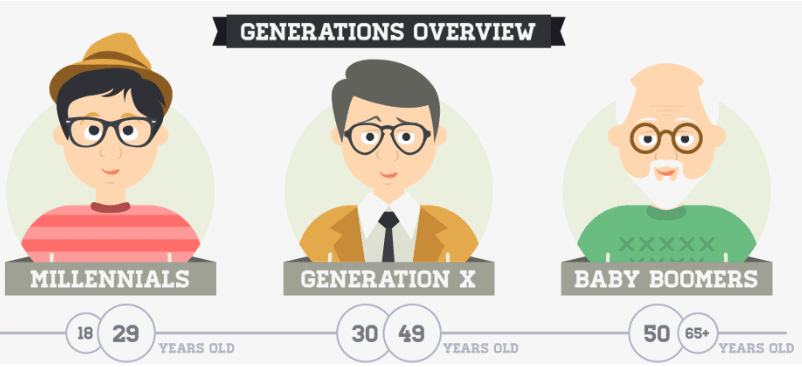 (Source: enterpriseappstoday.com)
(Source: enterpriseappstoday.com)
General Millennial Marketing Statistics
- Millennials are shopping more online than in physical stores, with 27% planning to increase their online spending.
- They will spend 50% more than Gen Z on health and beauty items and 77% more on clothing and shoes compared to Baby Boomers.
- When it comes to electronics, 25% of millennials plan to spend more, compared to 19% of Gen Z and Gen X and 13% of Baby Boomers.
- Millennials also plan to spend more on luxury products than other generations.
- Millennials are active online shoppers, with 71% buying items through their mobile phones.
- They often make unplanned purchases (87%) and check reviews before buying (40%). Personalized ads are important to them, and they prefer short video content.
- They want brands to entertain them (80%) and value reliability.
- Social media plays a big role in their buying decisions, with 65% trusting recommendations from friends.
- 25% are more likely to purchase due to social media ads.
- Millennial Marketing Statistics stated that almost 25% engage more with online ads.
- 43% respond to humorous ads.
- 36% trust social media ads.
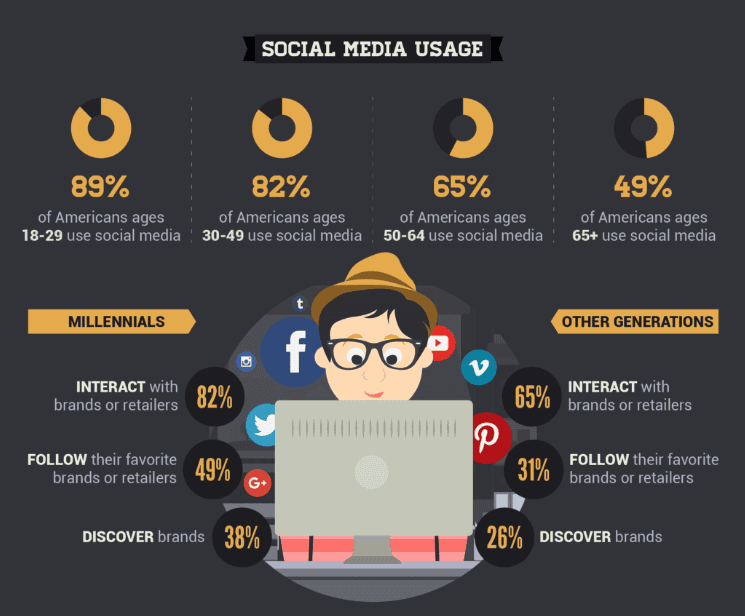 (Source: enterpriseappstoday.com)
(Source: enterpriseappstoday.com)
- Many millennials use ad-blockers and prefer seamless online experiences. They’re also drawn to loyalty programs, and 95% follow brands on social media.
- In 2023, there are 72.24 million millennials in the US.
- Most millennials (94%) visit restaurants at least once a month. On average, they spend $488.90 each month on groceries.
- Three-quarters of them prefer spending money on experiences instead of material items.
- Around 40% say their favorite online influencer understands them better than their friends.
- 73% of millennials plan to spend the same amount or more on online shopping in 2023 compared to the previous year.
- Financial knowledge is often low, so offering financial education can be a smart way to reach them.
- In short, marketing to millennials requires moving beyond traditional advertising methods.
- Brands must create personalized, authentic experiences that connect with millennials where they spend their time.
- It is crucial to show genuine support for their values, and offering affordable options or financial help will earn their loyalty.
How To Do Millennials Consume Media Marketing
- Millennials are very tech-savvy, with 85% owning smartphones, 78% having laptops, and 50% using tablets.
- They rely more on mobile devices than traditional media.
- Compared to other generations, millennials are more likely to own these devices, which makes them more connected and dependent on technology than older generations.
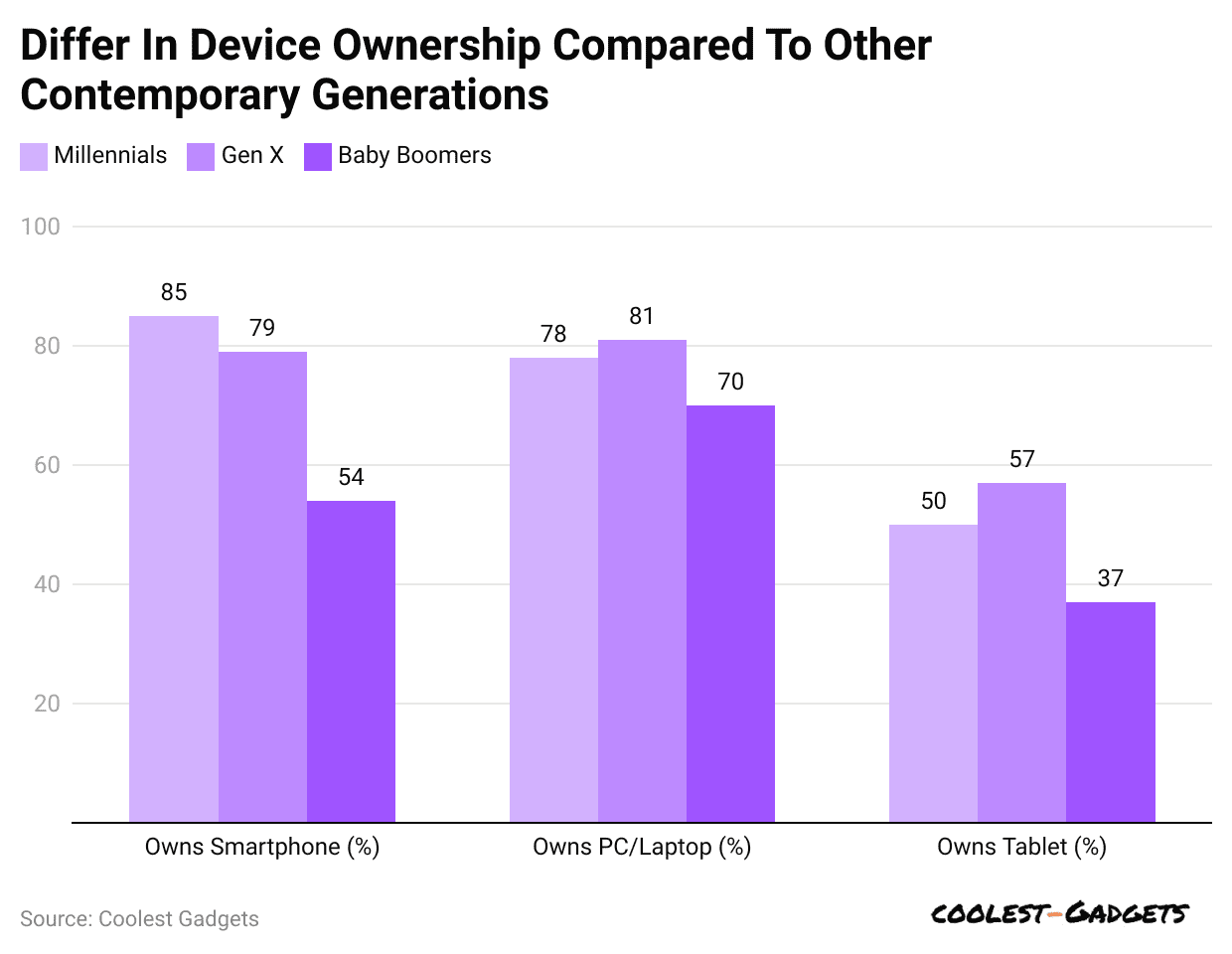 (Reference: onethreadapp.com)
(Reference: onethreadapp.com)
| Generations | Owns Smartphone (%) | Owns PC/Laptop (%) | Owns Tablet(%) |
|
Baby Boomers |
54 | 70 | 37 |
| Gen X | 79 | 81 |
57 |
|
Millennials |
85 | 78 |
50 |
- Millennials spend very little time on traditional media like print magazines and newspapers or listening to the radio.
- Only 31-35% of them engage with magazine content, and 20-48% read news on digital devices.
- They also watch less TV, averaging just 2.4 hours daily. Instead, they prefer consuming content on mobile devices, digital streaming, and social media, focusing on on-demand options rather than scheduled programming.
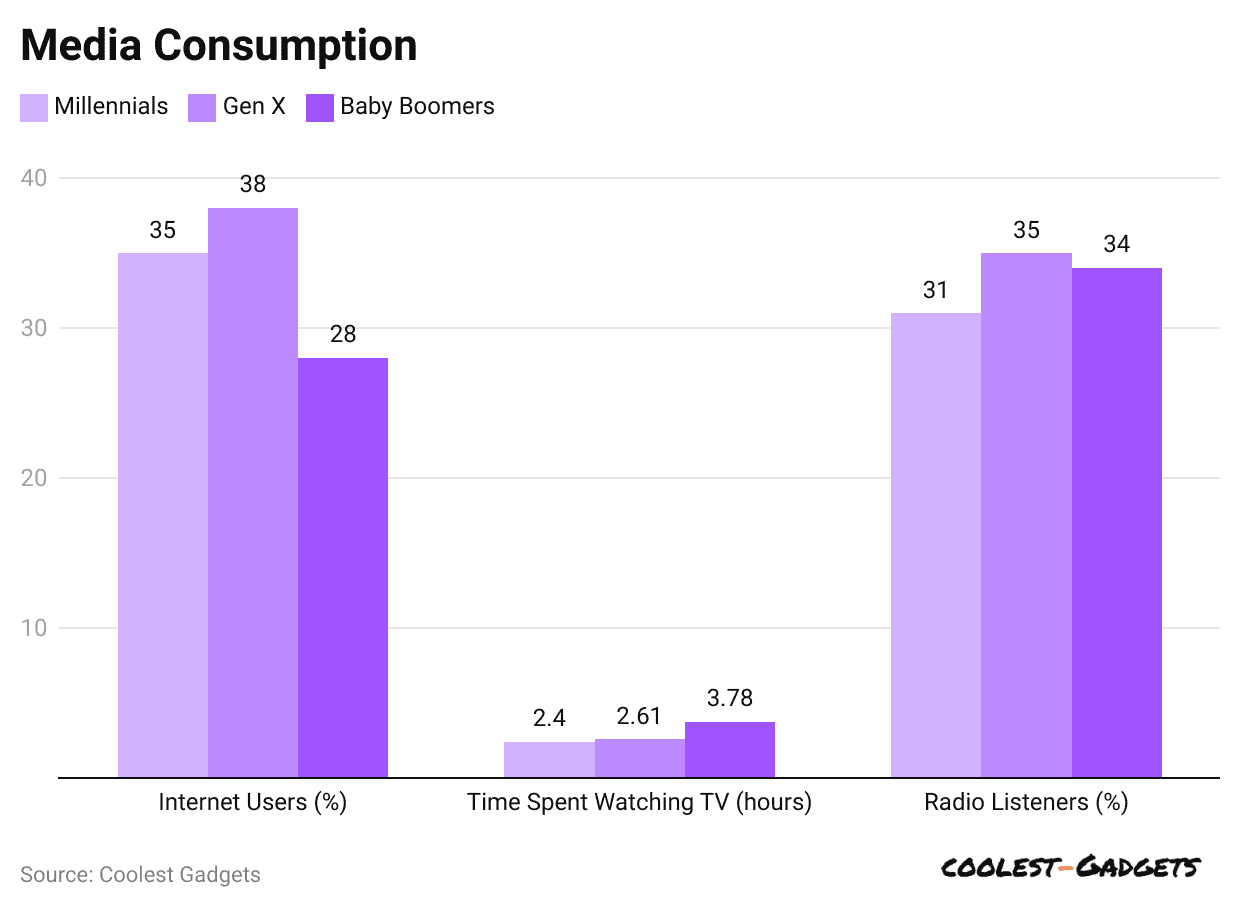 (Reference: onethreadapp.com)
(Reference: onethreadapp.com)
| Generations | Internet Users(%) | Time Spent Watching TV (hours) | Radio List (%) |
|
Baby Boomers |
28 | 3.78 | 34 |
| Gen X | 38 | 2.61 |
35 |
|
Millennials |
35 | 2.4 |
31 |
Millennial Consumer Behavior Statistics
- Over 35% of millennials are willing to spend more than $5,000 on travel, making them the top generation in travel spending.
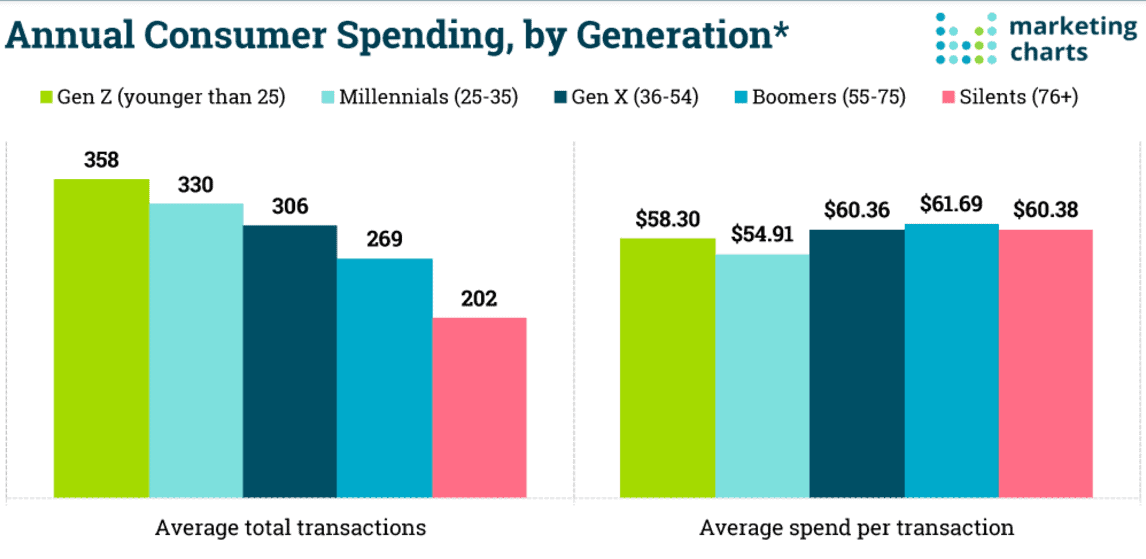 (Source: porchgroupmedia.com)
(Source: porchgroupmedia.com)
- Nearly 50% of millennials research local businesses online before visiting them.
- Around 72% of millennials prefer brands that offer loyalty programs.
- 31% of millennials check ratings, needing at least three stars to buy.
- Millennial Marketing Statistics stated that almost 35% of millennials trust user-generated content more than ads.
- 79% of millennials think advertising is essential for brands.
- Around 86% of millennials overspend on holiday gifts.
- 42% of millennials use ad-blockers.
- Almost 60% of millennials stay loyal to brands for over 10 years.
- 57% of millennial women make purchases based on a brand’s values.
- Millennial Marketing Statistics state that almost 50% of millennials buy products recommended by their favorite brands.
Millennials And Technology Statistics
- One-third of millennials have tried virtual reality.
- Technology has helped 73% of millennials improve their work-life balance.
- Half of millennials (50%) use tablets, though this varies across generations.
- Laptops and PCs are the top tools for work and study, with 81% of Gen X and 78% of millennials using them.
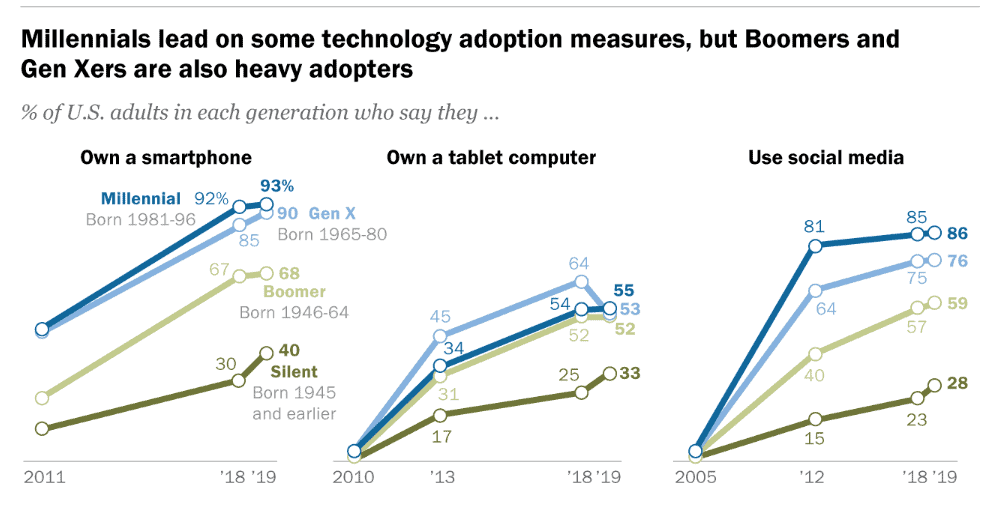 (Source: pewresearch.org)
(Source: pewresearch.org)
- 85% of millennials use smartphones.
- 31% of millennials read magazines, compared to 35% of Gen X and 33% of Baby Boomers.
- Baby Boomers (48%) read the most newspapers, while 32% of Gen X and 20% of millennials do.
Millennials Purchasing Habits Statistics
- The average annual income for millennials after taxes is $58,628.
- Millennials spend 21.6% of their income on housing, more than Gen X and Baby Boomers.
- On average, millennials save 9.8% of their income. They spend around $52,000 each year.
- Millennials’ total net worth is over $8 trillion, but only 5.8% of the total net worth of all generations.
- Millennials born in the 1980s have 34% less wealth than expected due to economic recessions.
- 23% of millennials prefer buying online before picking up in stores.
- 42% make purchases online using their smartphones.25% shop for groceries online.
- Millennial Marketing Statistics stated that almost 67% are concerned about online financial fraud.
- 91% prefer shopping online rather than in stores.
- Almost 44% choose online shopping for faster delivery and better variety.
- 47% shop on Amazon at least once a week.
- Nearly 60% prefer generic brands over name brands.
- 40% check online reviews before buying products.
- 30% feel more loyal to brands than specific products.
- 60% have been loyal to a brand for over 10 years.
 (Reference: lexingtonlaw.com)
(Reference: lexingtonlaw.com)
- 52% like shopping with brands that share their values.
- 44% of millennial parents will only shop with brands that share their social or political views.
- 96% believe brands should reward loyal customers.
- Millennial Marketing Statistics stated that almost 81% are motivated to spend more when part of a rewards program.
- 47% use ad blockers on their computers, and 29% on their smartphones.
- Around 74% share or use someone else’s login for streaming services.
- 75% think attending live events has more impact than online actions.
- 92% decide to share personal info based on an app’s appearance.
- Millennial Marketing Statistics stated that almost 30% ignore online ads.
- 77% worry about companies using their data.
- Millennials are 54% more likely to buy a product recommended by an influencer.
- Millennials spend an average of 211 minutes per day on apps or the internet.
- 8 million millennials have student loan debt, more than any other generation.
- The average student loan debt for millennials is $38,877.
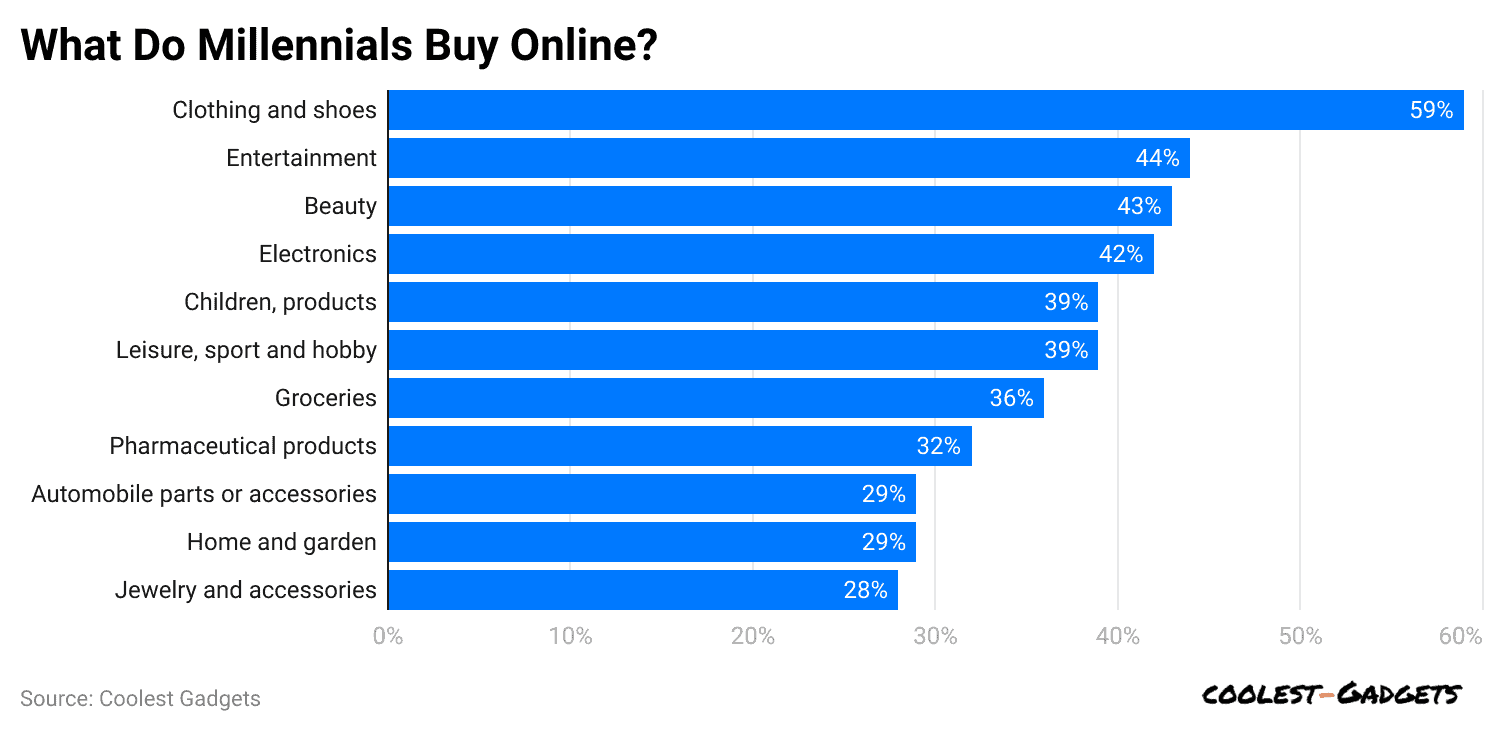 (Reference: oberlo.com)
(Reference: oberlo.com)
- Millennials hold 31.94% of all US student loan debt.
- 46% of younger millennials have an average of $26,000 in student loans.
- 42% of millennials regret taking out student loans.
- The average millennial credit card debt is $4,712.
- Younger millennials owe an average of $2,288 on credit cards, while older millennials owe $6,675.
- Over 50% of millennials say student debt has delayed home savings.
Millennial On Social Media Statistics
- Millennial Marketing Statistics stated that almost 86% of millennials use social media daily.
- 72% of millennials say they use social media more than they did last year.
- Millennials in countries like the US, UK, Germany, Brazil, and Japan prefer social media for entertainment.
- 99% of millennials would recommend a company on social media if they connected with it.
- Near y 95% of millennials use social media.
- Millennials prefer social media for product research.
- Gen Z, millennials, and Gen X like social media in the US, UK, and Japan.
- Almost 33% of millennials post on social media daily; 51% do so weekly.
- Millennials have an average of 8.4 social media accounts.
- 60% of millennials engage with brands on social media for customer service.
- Male millennials follow sports, business, and gaming accounts.
- Facebook is still the most popular platform for millennials.
- Female millennials follow food, fitness, and beauty influencers.
- 68% of millennials expect a smooth experience across all platforms.
 (Source: passivesecrets.com)
(Source: passivesecrets.com)
- Black and Latino millennials are more likely to choose other websites than Facebook.
- Black millennials find social media more important than white millennials do.
- 34% of millennials get their news from social media, followed by 25% using online news and 23% using apps.
- By 2027, Gen Z and millennials will make up over half of US social media users.
- TikTok is popular with both Gen Z and millennials, who are also the most loyal users.
- Millennial Marketing Statistics stated that almost 84% of millennials don’t trust traditional advertising.
- 44% of millennials would promote products on social media for rewards.
- Social media users watch most sports videos, with Gen Z (58%), millennials (59%), and Gen X (53%) watching the majority.
- Gen Z (84%) and millennials (73%) use social media to discover TV and video content.
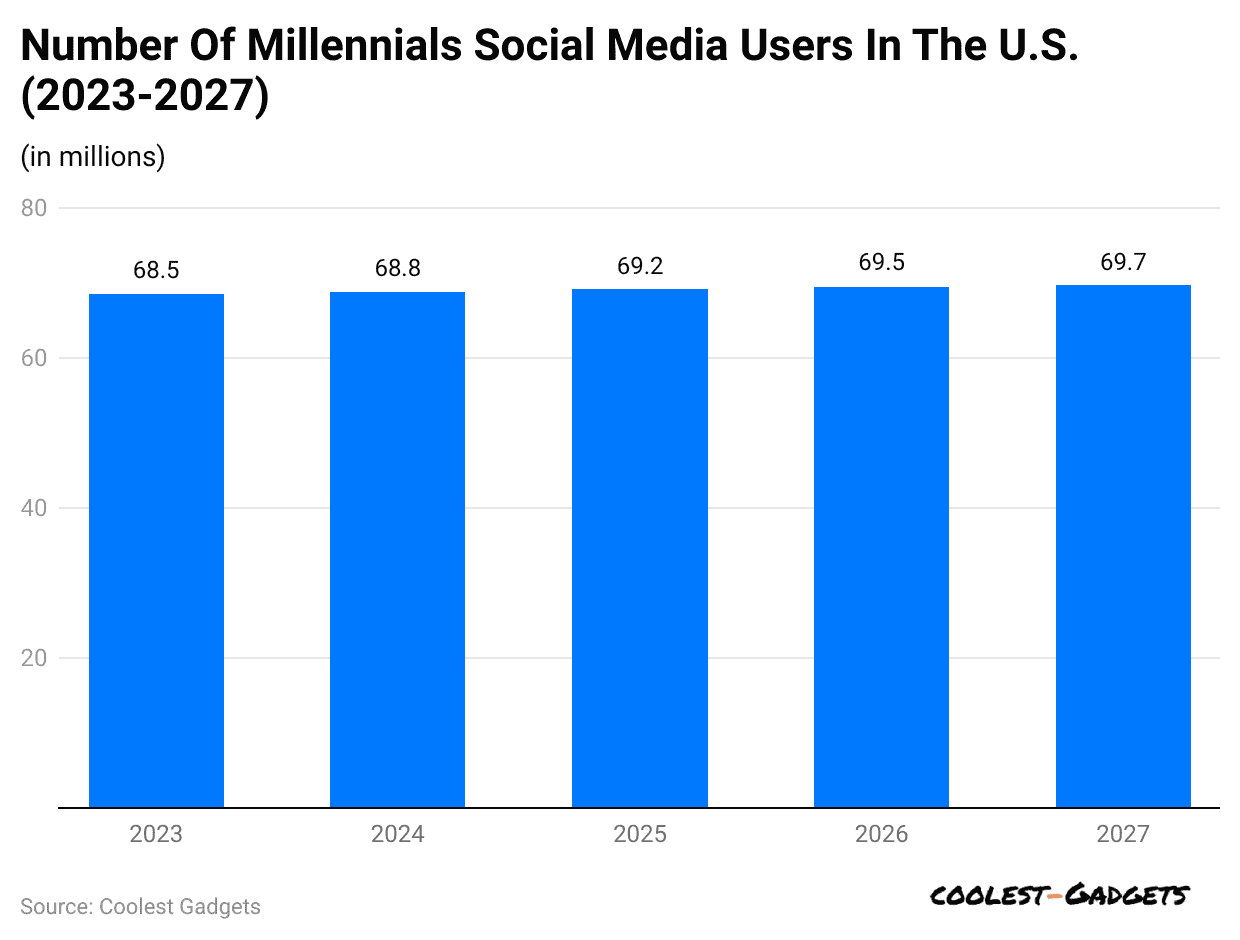 (Reference: oberlo.com)
(Reference: oberlo.com)
- 46% of millennials use social media for customer service issues.
- 61% of millennials use TikTok to find relevant content, and 59% use YouTube.
- Millennials use emojis in 55% of their texts and messages.
- 69% of millennials use emojis more when flirting or dating.
- Millennial Marketing Statistics stated that almost 47% of millennials feel social media positively affects their mental health.
- 3% of US millennials say TikTok negatively impacts their mental health.
Challenges of Marketing to Millennials
- Marketing to millennials can be challenging because they have short attention spans (only 8 seconds, according to a Microsoft study), are sceptical of traditional ads, and constantly change their preferences.
- Content needs to be short and engaging, delivered on social media platforms that match their values, like how Urban Outfitters’ #UOOnYou campaign lets people express themselves.
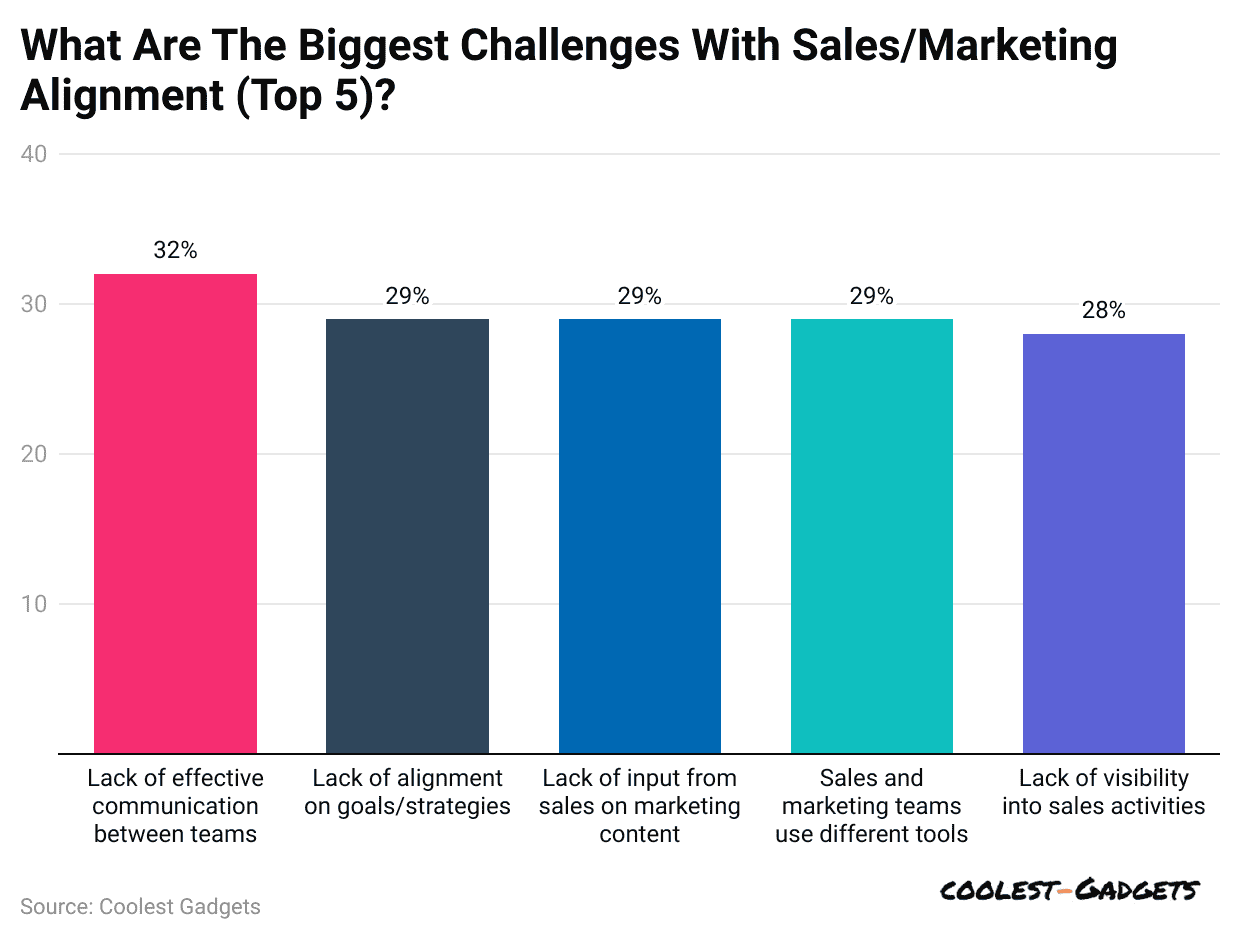 (Reference: hubspot.com)
(Reference: hubspot.com)
- Using technologies like geo-fencing, beacons, and augmented reality and allowing product customization can grab their attention.
- Subtle and relevant ads based on their interests work better than traditional “buy now” ads.
- 60% of millennials say the brands they buy from reflect their lifestyle, so authenticity is important.
- Nearly half of them (47-50%) live paycheck to paycheck, making affordability a key factor.
Here are some challenges you need to be aware of and ways to overcome them:
- Getting Their Attention
- Millennials have an average attention span of just 8 seconds, according to Microsoft.
- That means marketing content must quickly grab their attention. With so many ads today, standing out is hard. Brands need to be creative and offer something unique.
- Technologies like Augmented Reality (AR), personalized ads, product customization, and location-based tactics like geo-fencing and beacons can better engage them.
- It’s all about offering something fresh and aligning with their values.
- As millennials’ spending power continues to grow, understanding their habits and preferences will be essential for brands’ success.
- Finding the Right Medium
- 60% of millennials use mobile devices as their primary way to access the internet, which means marketing must work across different devices.
- They’re also more likely to stream content rather than watch traditional TV ads.
- Older advertising methods, like TV, radio, and print, are less effective with millennials.
- They prefer using their devices for almost everything, from socializing to shopping. Instead of cable TV, they turn to streaming services like Netflix and Hulu.
- They listen to music apps instead of FM radio and read digital magazines and books instead of print media.
- To truly connect with them, brands need to be where millennials already are, both online and offline.
- A cross-platform approach, offering a seamless experience across different channels, can be especially successful.
- Emphasizing Authenticity and Shared Values
- 50% of millennials believe the brands they buy from reflect their lifestyle and identity.
- Marketing needs to match their values, like sustainability and supporting social causes, rather than using hard-sell tactics.
- Millennials are turned off by phrases like “buy now” or tactics that create fake urgency. They prefer to make informed decisions based on facts and peer reviews.
- Instead of traditional sales messages, brands should offer more personalized ads using digital marketing techniques combined with business intelligence tools. The key is to offer suggestions based on their behaviour, not just direct sales pitches.
- Using Creative Ways to Grab Attention
- To cut through the noise of daily advertising, brands need to use innovative approaches.
- Augmented reality can help engage millennials by animating physical spaces with branded content that they share on social media.
- Personalized ads based on their interests will feel more relevant to them.
- Location-based tools like beacons and geo-fencing can connect with millennials on their phones when they’re out shopping.
- These methods give value instead of adding to the clutter of ads.
- Offering Financial Advice and Affordability
- Almost half of millennials (47-50%) live paycheck to paycheck and often struggle with low financial knowledge.
- Many face student loans and credit card debt, making them more cautious about spending.
- Marketing should focus on providing tools and advice for managing money.
- Brands that position themselves as financial partners by offering helpful resources and affordable pricing can build loyalty.
- Providing personalized recommendations based on millennials’ financial situations will help brands stand out.
- Being transparent and addressing their financial concerns will build trust.
Conclusion
Millennials and Gen Z behave similarly worldwide, relying heavily on technology for quick answers. If they don’t find what they’re looking for, they ask others. To appeal to these generations, companies need to include technology in their marketing strategies. Understanding their preferences is key because they represent the future of the market.
Although convincing them can be tough, recognizing their trends and behaviors is crucial for businesses to succeed. We have shed enough light on Millennial Marketing Statistics through this article.
Sources
FAQ.
Around 84% of millennials say that content created by other users on a company’s website can influence their buying choices. Plus, 57% of millennials find new fashion trends on social media, so using influencers for marketing is a smart move for fashion brands.
Gen Z shoppers have strong beliefs about the world and aren’t afraid to speak up. They care deeply about social and political issues and expect brands and advertisements to be genuine.

Saisuman is a talented content writer with a keen interest in mobile tech, new gadgets, law, and science. She writes articles for websites and newsletters, conducting thorough research for medical professionals. Fluent in five languages, her love for reading and languages led her to a writing career. With a Master’s in Business Administration focusing on Human Resources, Saisuman has worked in HR and with a French international company. In her free time, she enjoys traveling and singing classical songs. At Coolest Gadgets, Saisuman reviews gadgets and analyzes their statistics, making complex information easy for readers to understand.







